A few months ago, my friend and former coach Steve Giddins decided to sell the greater part of his fantastic chess book collection. My tiny flat is already creaking under the weight of the review copies I receive every month from New in Chess, but I purchased the maximum I could fit in! One excellent book I’ve been spending a lot of time on is a collection of Best Games by 3-time Hungarian champion, Istvan Bilek. Bilek was a strong player in the 1960s and early 1970s, rated 2500 (=73rd in the world) in January 1971 – the 3rd highest Hungarian player behind Lajos Portisch and Laszlo Szabo, equal with Gyozo Forintos and ahead of Istvan Csom and Levente Lengyel.

His book is in Hungarian so I’m unfortunately not getting much out of Bilek’s recollections from his life, but – despite some rather odd letters for the pieces – the games are no problem! Bilek was an interesting player, playing both Open Sicilians and 1.Nf3 2.g3 systems as White and the Modern Opening with Black. As I’ve mentioned before, I like reading through old books and trying to spot analytical mistakes as a training exercise. The scepticism that makes you question what is written down on the page is an excellent frame of mind in practical games where you should always assume the opponent’s last move is a mistake just waiting to be exposed!
Judging from his games, nerves (or maybe severe time-trouble?) seem to have been a problem for Bilek as there are a number of missed opportunities and panicky reactions to unsound tactics in his games. But there are many good games too, and many interesting variations unearthed by Bilek in his analysis.
In this column, we take a look at a tactical battle with the great Mikhail Tal in 1967! This game is annotated by Sergei Dolmatov for Chessbase but something seems to have gone wrong there – for such an exceptionally strong player, these annotations really don’t do justice to the fight!
Bilek,Istvan – Tal,Mihail [A05]
October Revolution 50 years Moscow (3), 23.05.1967
[matthewsadler.me.uk]
1.Nf3
No 1.e4 against Tal! Wise man!
1…Nf6 2.g3 b5 3.Bg2 Bb7 4.0–0 e6 5.d3 d5
5…Be7 6.e4 0–0 7.Nd4 was an original idea tried by Bilek in 1985 against old rival Lajos Portisch. 7…a6 8.Nb3 with the dual threat of Na5 and e5! 8…Nc6 9.e5 Nd5 10.Re1 with a complicated position.
6.Nbd2 Be7 7.e4 0–0 8.Qe2 c5 9.Re1 Nc6 10.c3 a5 11.exd5
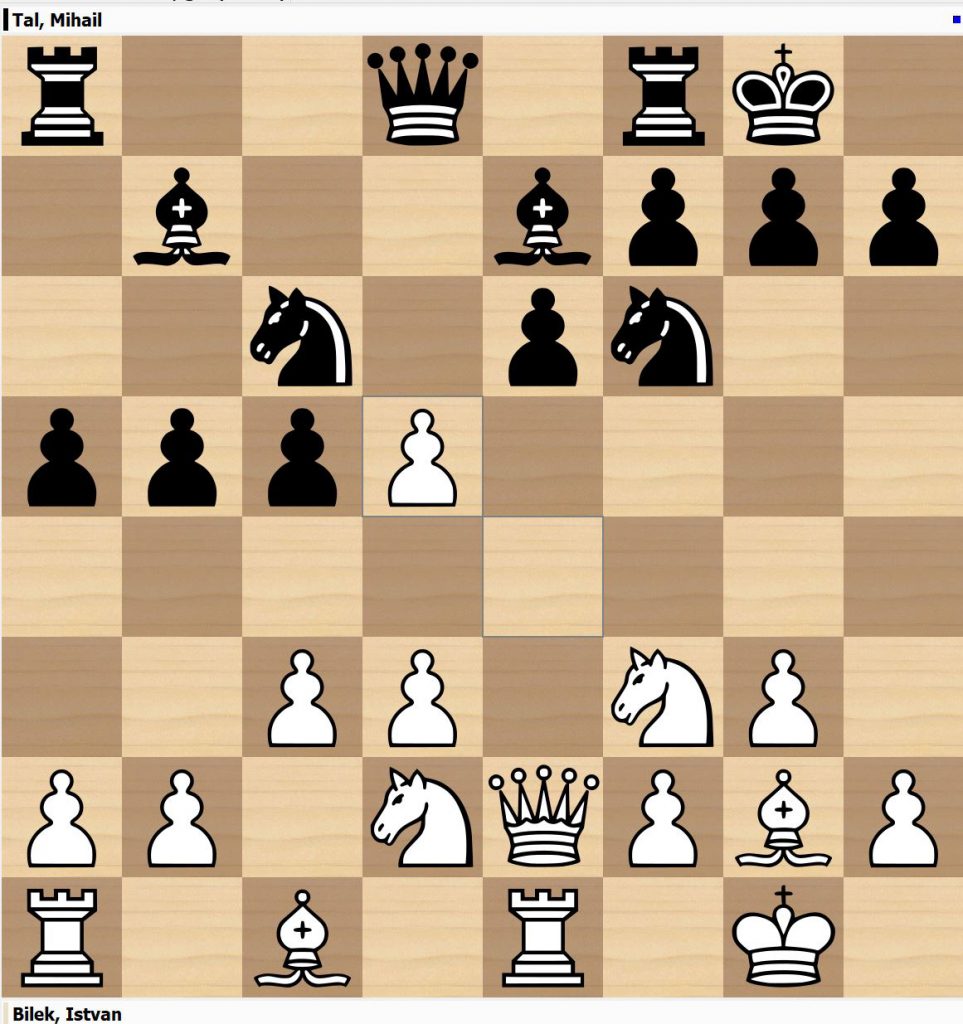
An unusual twist in a King’s Indian Attack position. White normally blocks the centre with e4–e5 and then starts up kingside play with h2–h4–h5–h5 and Nd2–f1–h2–g4. Bilek spots small flaws in Black’s position and tries to exploit them in a concrete way.
11…exd5
11…Nxd5 12.a4 would be irritating for Black who – after 10…a5 – can no longer defend the pawn on b5 with the a-pawn. 12…b4 13.c4 Nf6 14.Nb3 followed by Be3 and d4 looks pleasant for White. Tal therefore prefers to recapture on d5 with the pawn and keep control of c4.
12.d4
Highlighting the loose pawn on b5, now attacked by the queen on e2. It’s just a pin-prick however, and Black has a choice of reasonable-looking defences.
12…Qb6 13.dxc5 Bxc5 14.Nb3 Rfe8 15.Qc2
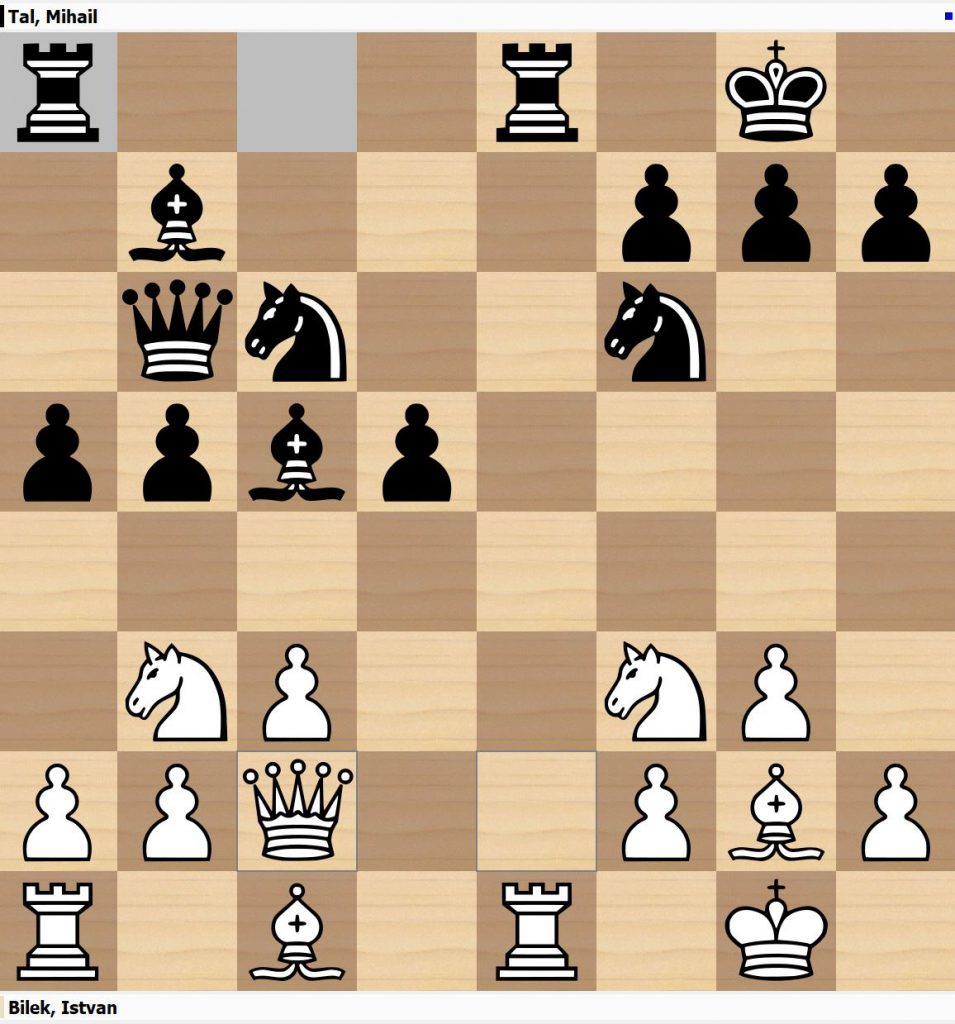
My first impression was that this was a little awkward for White, being forced to move the queen for a second time in the opening. However, Black is actually the one who has to prove something in this position. If the dark-squared bishop retreats (for example – 15…Bf8) to avoid giving White the 2 bishops, White replies with 16.Be3 and can claim that a slight advantage due to Black’s isolated d-pawn and White’s solid grip on the d4 square. Black may also regret moving the b-pawn forwards to b5 in this position, as the c5 square is now harder to defend.
15…d4
Tal goes for activity!
16.Qf5
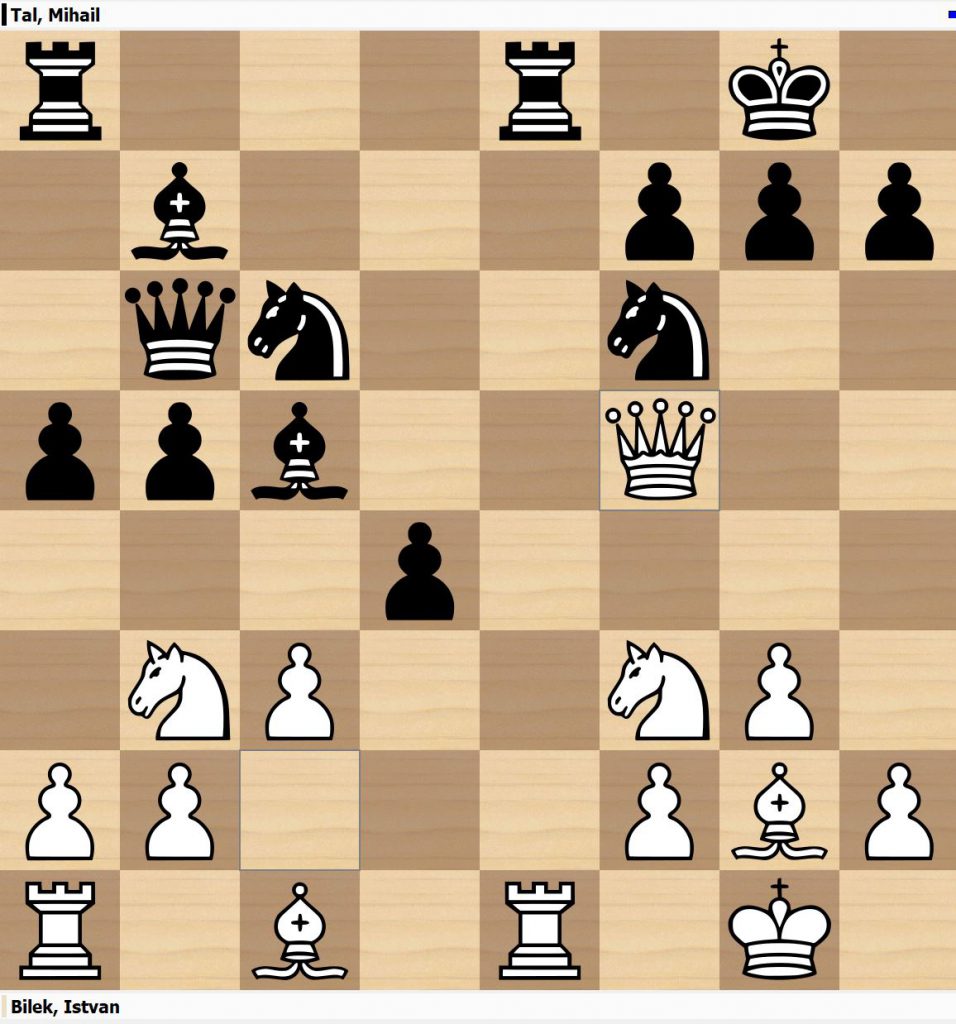
Exclamation mark from Bilek! It’s not the engines’ favourite move, but an excellent and surprising practical choice. Black is forced to solve some unusual problems.
16…Rxe1+ 17.Nxe1 Re8 18.Nf3 Bd6
It’s at this point that Tal loses the thread of Black’s position. It’s fairly clear that White’s next developing move will be 19.Bg5 attacking the knight on f6. In that case, after Bxf6 …gxf6, Qxf6 Black would much rather have the bishop on f8 to defend the Black kingside than remote on d6 and en prise.
18…Bf8 19.Bg5 (19.Nbxd4 Nxd4 20.cxd4 Bxf3 21.Qxf3 Qxd4 is no problem at all for Black.) 19…Bc8 20.Qc2 dxc3 21.bxc3 a4 22.Nbd4 Nxd4 23.Nxd4 Bd7 24.h3 h6 25.Be3 Qc7 26.Qd3 was one game in a match I played between Stockfish and Fat Fritz from positions in this game. White has a touch more central control but Black has no problems in principle.
19.Bg5 Ne4
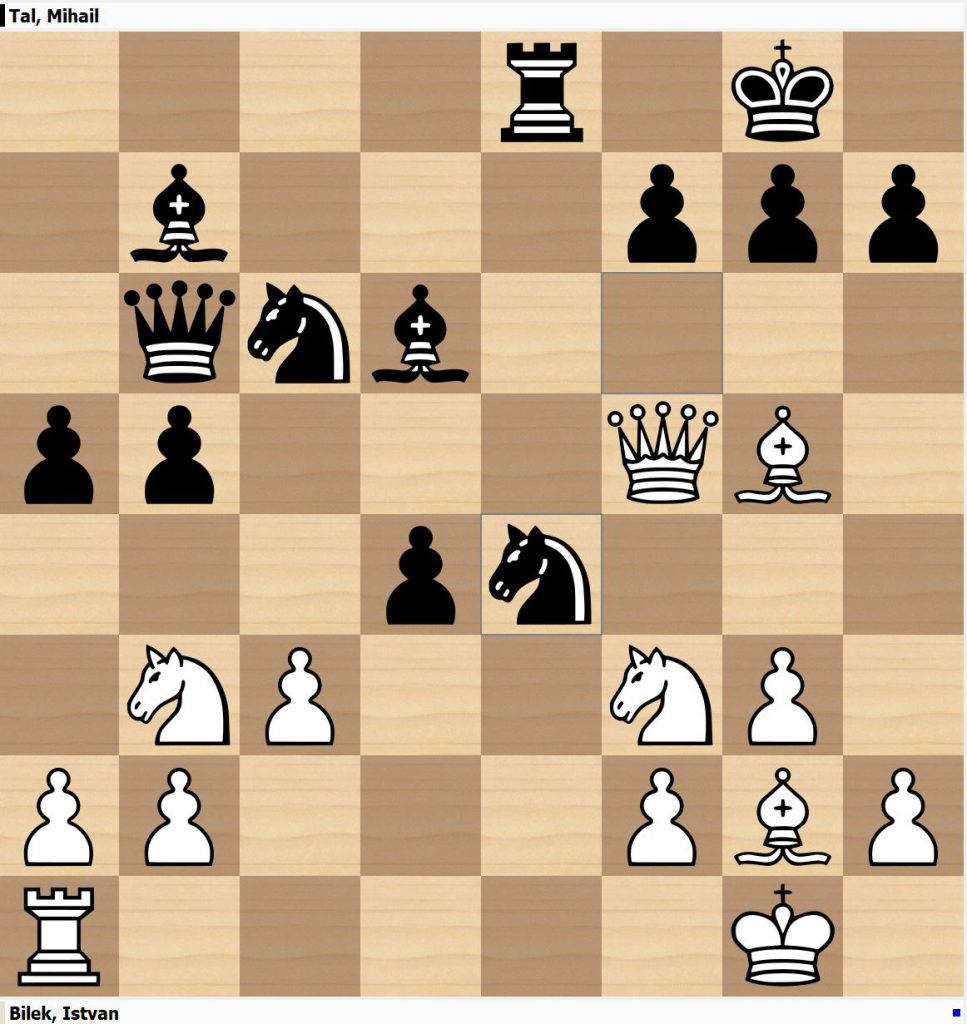
This is really risky!
19…Ne7 20.Qd3 dxc3 21.bxc3 Be4 22.Qd4 Qb8 23.Bxf6 Nc6 24.Qd1 gxf6 25.Nh4 Bxg2 26.Qg4+ Kh8 27.Kxg2 Bf8 28.Rd1 Ne5 was another engine game. White is a touch better – f6 is a more annoying weakness than c3 – but still well within drawing boundaries.
20.Re1
The engines flag this as a big mistake: Bilek makes no mention of it!
20.Qd7 Rf8 21.Nfxd4 wins a clear pawn!
20…Ne7
Another poor move from Tal. I guess he was trying to be extra tricky, because I would have expected him to spot the opportunity he had on this move!
20…dxc3 Uncovering an attack on the f2–square by the queen on b6. 21.Rxe4 Rxe4 22.Qxe4 Ne5 23.Qf5 g6 24.Qf6 cxb2 25.Nfd2 Ng4 26.Qd4 Qxd4 27.Nxd4 Ba6 was the subject of a few engine games! Just 2 pawns for the piece but hard to get at the pawn on b2 or bring the White king closer. 28.Bf3 Ne5 29.Be2 Nc4 30.Nb1 b4 31.Bf6 a4 32.Nb3 a3 33.Kf1 Kf8 34.Ke1 h6 35.Kd1 Bb5 36.Bd4 Ke7 37.Nc5 Ke8 38.Nb3 and the engines seemed to have reached a standoff! Tal’s move 20…Ne7 was where Bilek started to analyse quite deeply, and where I got interested too!
21.Bxe7
2 question marks from Bilek!
21.Rxe4 was Bilek’s moment of glory that he also points out in his notes!
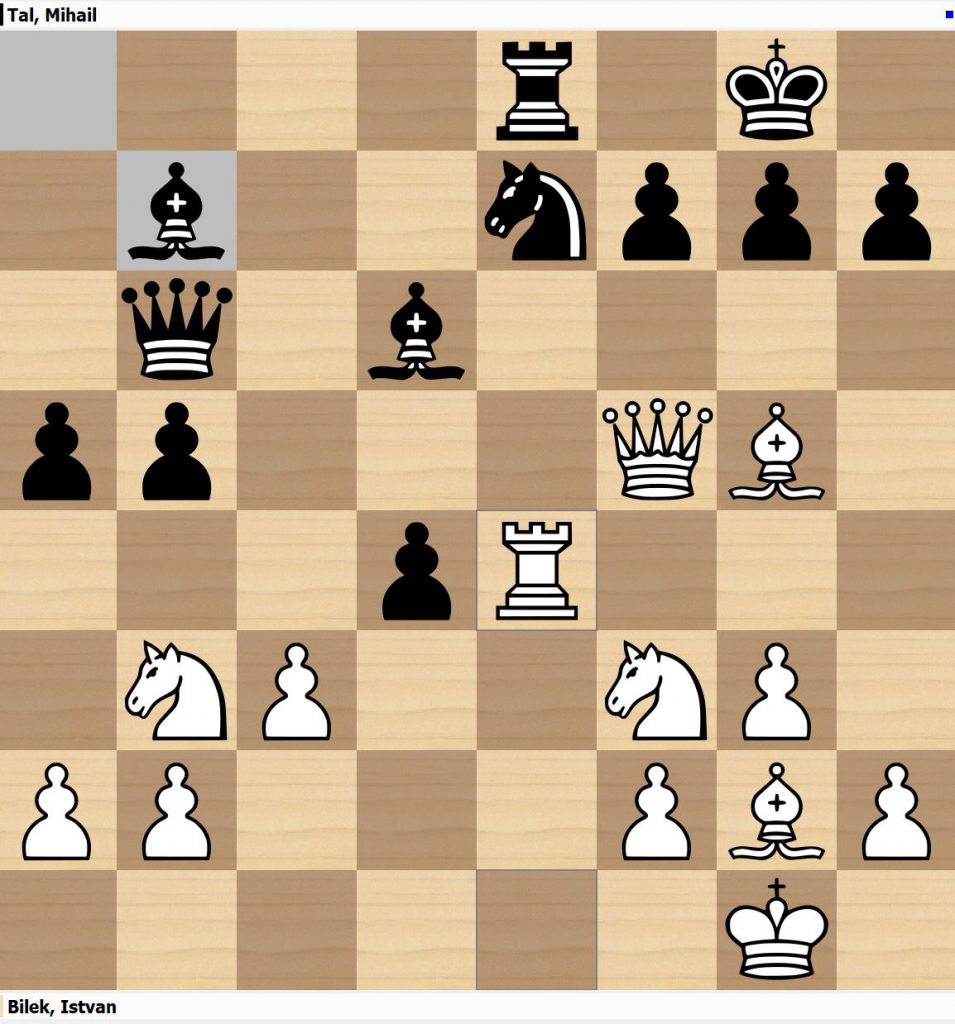
21…Nxf5 22.Rxe8+ Bf8 but now Bilek mentions the best variation but rejects it in favour of a beautiful but flawed line.
23.Nfxd4 was Bilek’s main line 23…Nd6 24.Bd8 Astonishing how – out of nowhere – the Black queen is so short of squares! 24…Qa7 (24…Qa6 25.Nc5 Qa7 26.Bb6 Nice!!
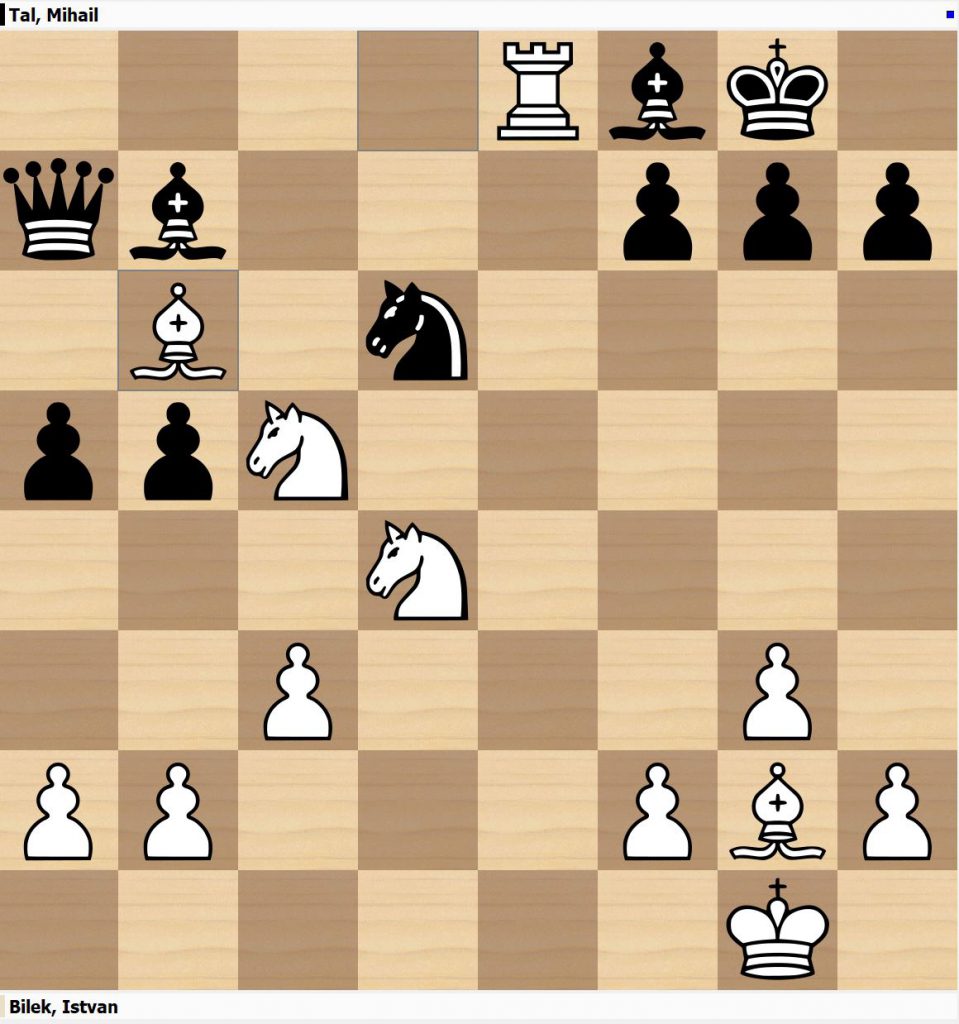
26…Qxb6 27.Rxf8+ is Bilek’s lovely line. 27…Kxf8 28.Nd7+ wins the queen with a piece extra for White.) 25.Nxb5 Another exclamation mark from Bilek, but it didn’t take me long to spot the flaw, and my engines confirm it. 25…Nxb5 is Bilek’s main line: 26.Be7 h5 27.Bf1
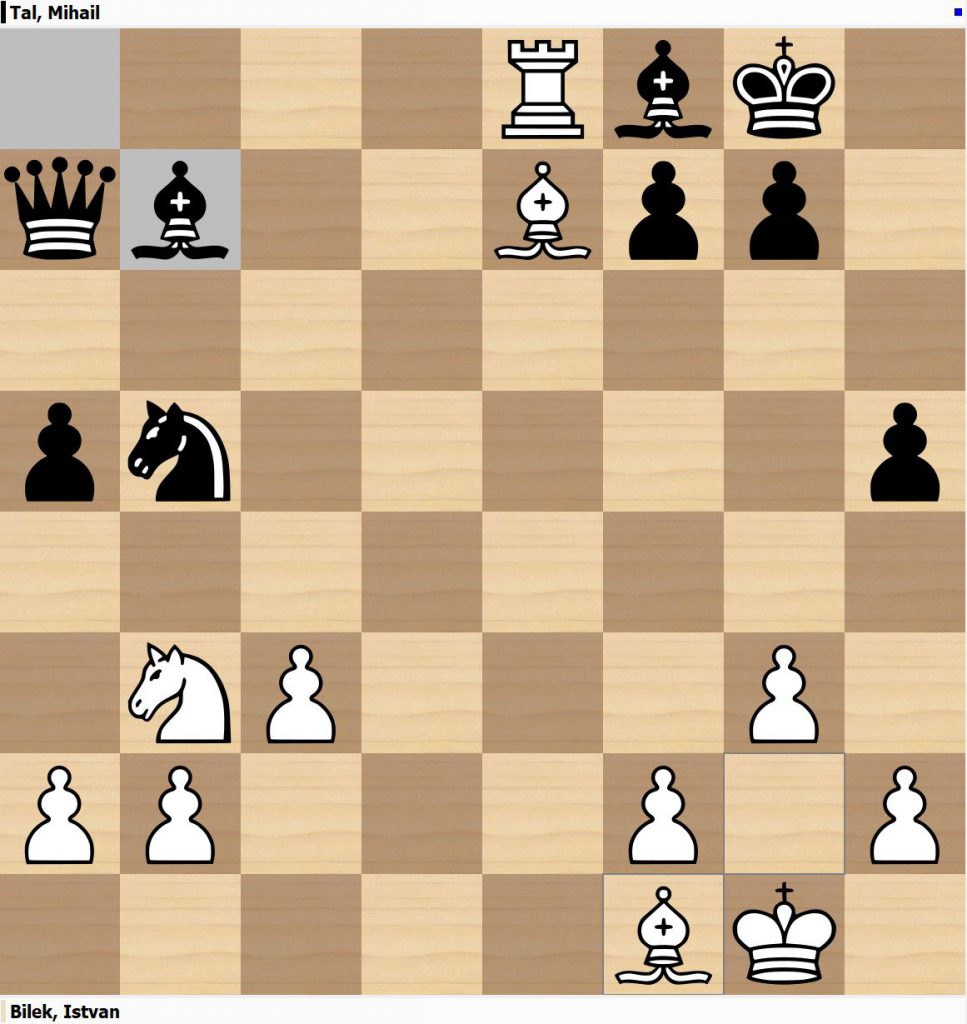
2 exclamation marks! is the point of Bilek’s line which is indeed confirmed by the engine. The Black king is indeed very short of squares, and funnily enough… so is the Black queen! 27…Nc7 28.Rxf8+ Kh7 29.Bc5
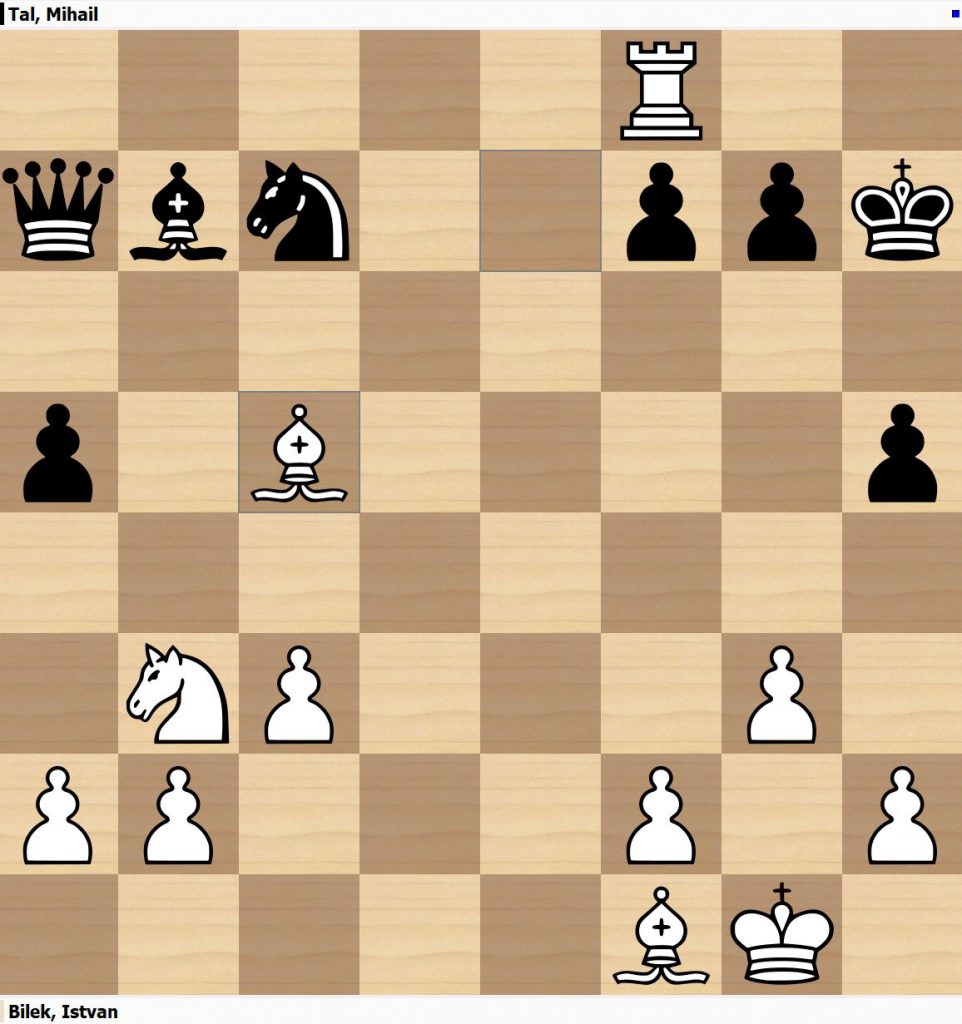
is the beautiful main point!)
25…Qa6 however was my refutation … and the engine confirms White is busted.

26.Nxd6 Bxg2 Threatens mate on f1! 27.Kxg2 Qxd6 With one threat of …Qd7 and an even nastier one as well… 28.Be7 Qc6+ is the cruel point!
23.Ne5 was the line I analysed and looks strongest. 23…Qc7 (23…Qd6 24.Bxb7; 23…Bxg2 24.Rxf8+ Kxf8 25.Nd7+ wins) 24.Bd8 Qd6 (24…Qc8 25.Bxb7 Qxb7 26.Nc5

26…d3 (26…Qd5 27.Ncd7 h5 28.Nxf8 Nd6 29.Nfg6+ is another knight fork combination! 29…Nxe8 30.Ne7+) 27.Ncd7 h5 (27…h6 28.Rxf8+ Kh7 29.Rxf7 d2 30.Nf6+ Kh8 31.Rf8#) 28.Rxf8+ Kh7 29.Nxf7 d2 30.Rh8+ Kg6 31.Nfe5#
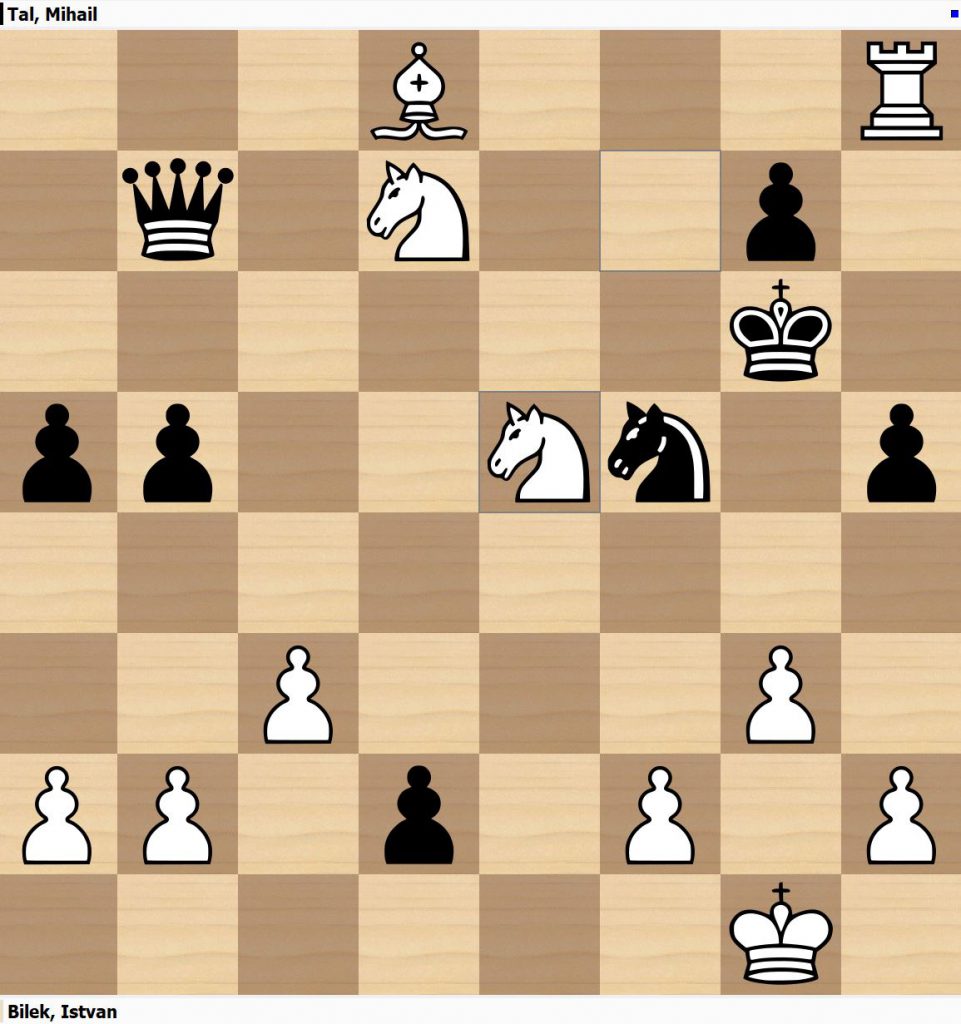
is a lovely mate!) 25.Nxd4 Nxd4 26.cxd4 Bxg2 27.Be7 Qxe7 28.Rxe7 Bxe7 29.Kxg2 should be a winning ending for White.
21…g6
Now it’s tricky for White.
22.Qh3 dxc3
Again opening an attack against the f2–pawn!
23.Rxe4 cxb2
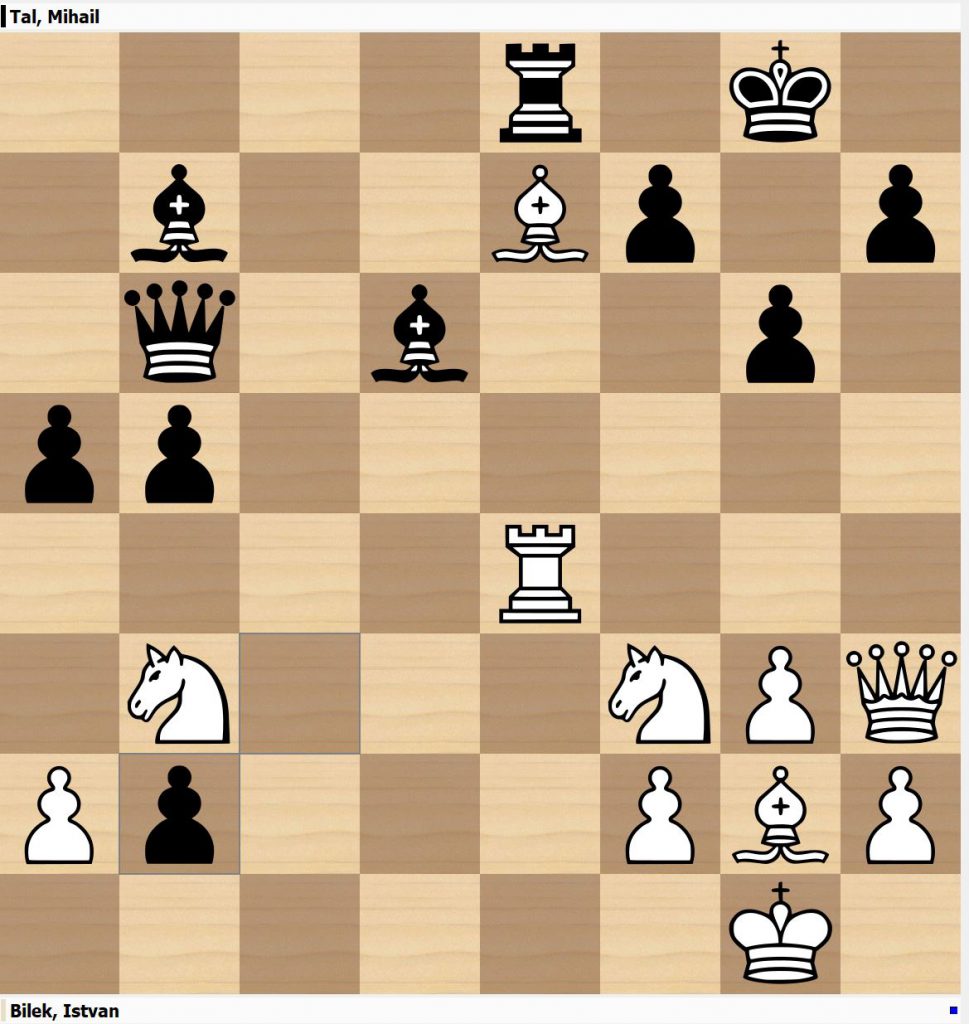
Two exclamation marks from Bilek!
24.Re1 Rxe7 25.Rb1 a4 26.Nbd4
Two question marks again from Bilek, but in fairness it’s already very bad!
26.Rxb2 axb3 27.axb3 was recommended by Bilek as the last chance, but it didn’t last long in my engine games! 27…Qa7 28.Rb1 Bc5 29.Rf1 Bxf2+ 30.Kh1 Be3 won very quickly
26…Bxf3 27.Nxf3 Re2 28.Rf1 Rxf2 29.Qc8+ Kg7 30.Qc3+ f6 0–1
It’s all collapsed! A lucky escape for Tal!
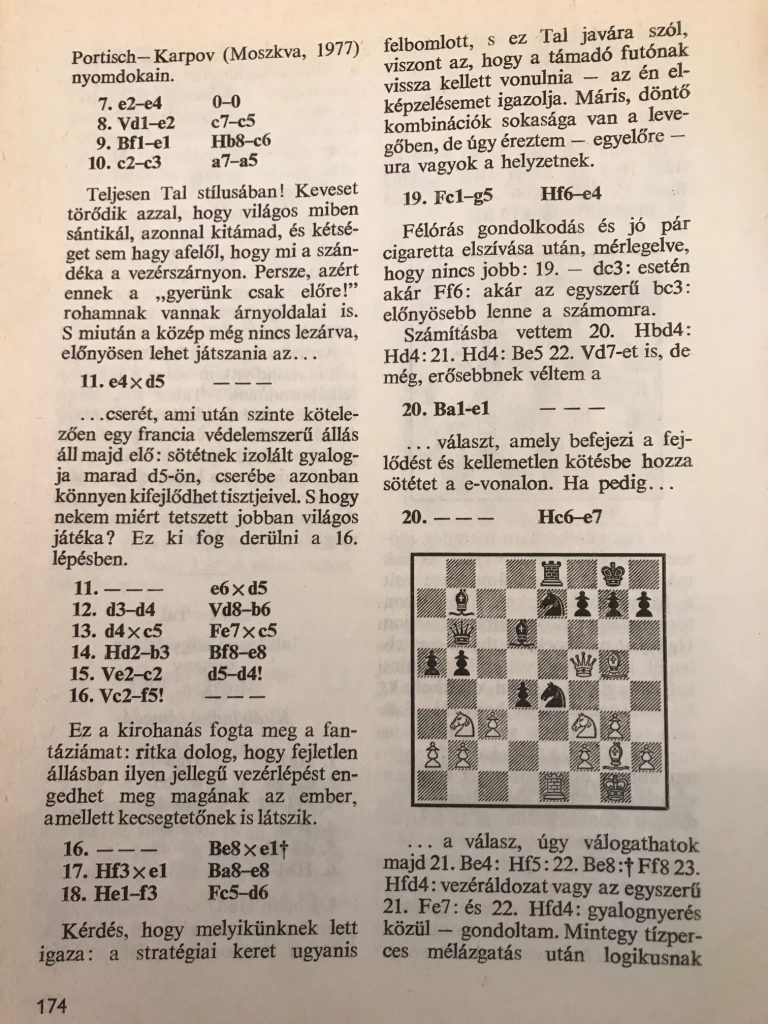
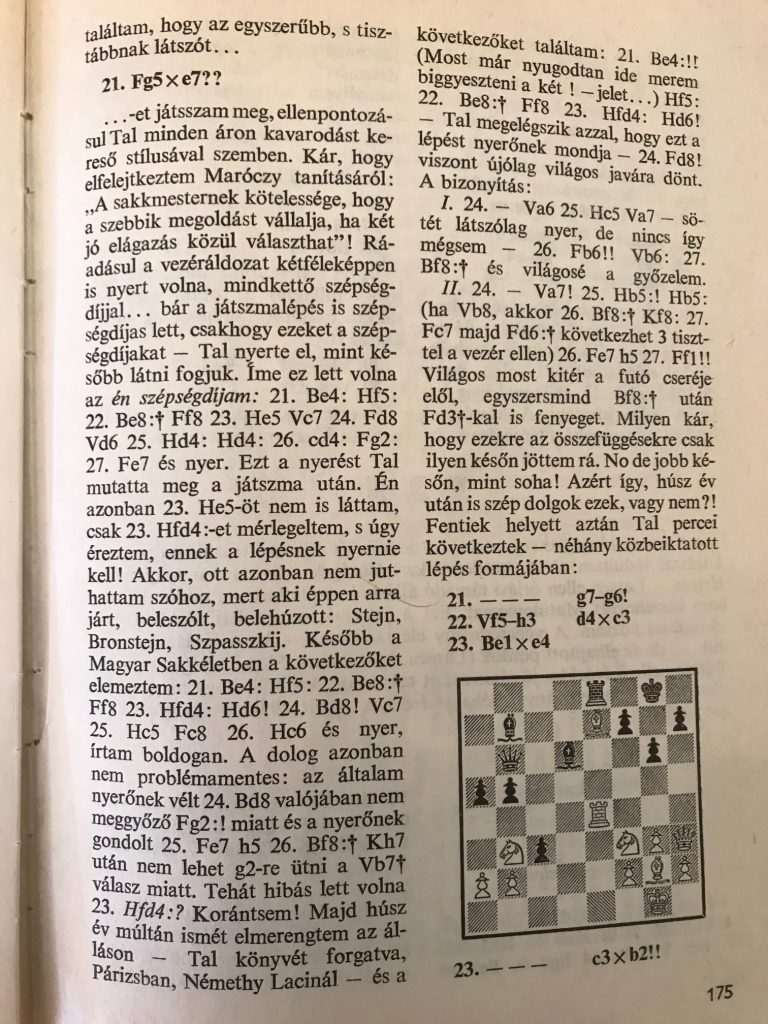
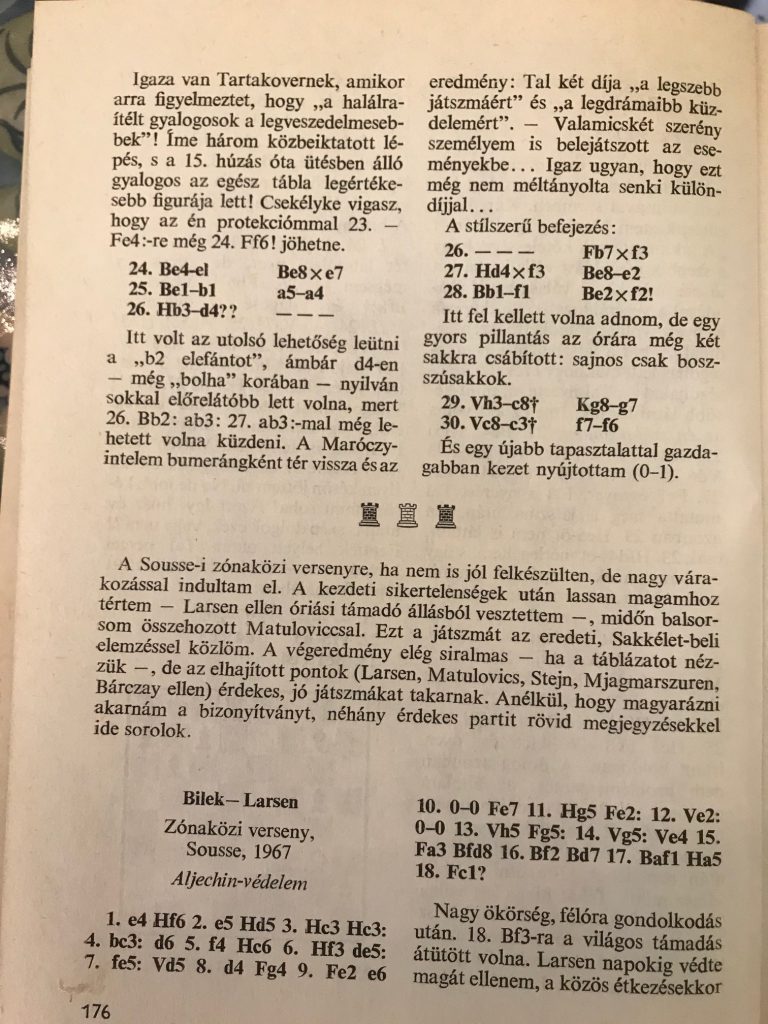




You can get an idea of Bilek’s comments by using https://www.onlineocr.net/ followed by Google Translate.
He did the analysis 20 years later in Paris after reading Tal’s Life and Games in which the game was included.
In my edition of “Tal’s Life and Games”. Tal is not mentioning 20. Qd7.
Thanks!! I Forgot completely that this game might be in Tal’s Best Games! I’ll take a look! Best Wishes, Matthew